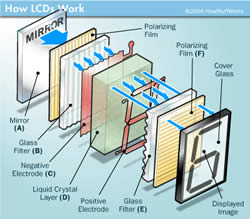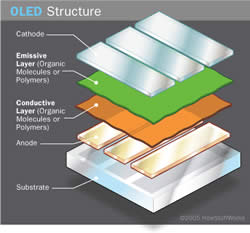Difference between LCD and OLED
Key Difference: LCDs (Liquid Crystal Display) are displays that use liquid crystals sandwiched between two sheets of polarizing material. The images are displayed when electrical charge is applied to the crystals. OLED (organic light-emitting diode) is a type of LED (light-emitting diode), where a layer of organic materials are placed between two electrodes on a substrate. OLEDs are thinner than LCDs, it also consumes less power and has a higher screen refresh rate compared to LCDs. The life span of an OLED is less, compared to LCD due to the short life span of the blue organic material. An OLED can emit light, removing the need for a backlight.
 LCDs and OLEDs are different types of displays that are used for electronic devices such as TV screens, cellphone screens, etc. LCDs (Liquid Crystal Display) are displays that use liquid crystals sandwiched between two sheets of polarizing material. The images are displayed when electrical charge is applied to the crystals. Liquid crystals are neither in solid state nor in liquid, or maybe a little bit of both. A fair amount of heat turns the liquid crystal into real liquid.
LCDs and OLEDs are different types of displays that are used for electronic devices such as TV screens, cellphone screens, etc. LCDs (Liquid Crystal Display) are displays that use liquid crystals sandwiched between two sheets of polarizing material. The images are displayed when electrical charge is applied to the crystals. Liquid crystals are neither in solid state nor in liquid, or maybe a little bit of both. A fair amount of heat turns the liquid crystal into real liquid.
An LCD uses a select type of liquid crystal known as twisted nematics (TN), which are twisted in shape. Applying a current to these crystals causes them to unwind to a certain degree depending on the voltage. A LCD is in a layer formation, it starts with a mirror on the back for reflection, followed by a piece of glass that has a polarizing film on the bottom side, and a common electrode plane made of indium-tin oxide on top. After that is a layer of liquid crystals, followed by another piece of glass with an electrode and another polarizing film, which is at a right angle to the first one. The LCD is then hooked up to power source that provides a charge to the crystals and causes them to create an image on the screen. LCDs also have a backlight that makes the image visible to the user.

OLED (organic light-emitting diode) is a type of LED (light-emitting diode), where a layer of organic materials are placed between two electrodes on a substrate. An OLED has the following layers; a substrate that supports the OLED, an anode that removes electrons when current is applied, organic layers of color, conducting layer, emissive layer and a cathode on the top. OLED can be applied to a substrate in three different ways; vacuum deposition (in a vacuum chamber the organic layer is heated until evaporation and then allowed to cool on the substrate), organic vapor phase deposition (in a low-pressure hot-walled reactor chamber, evaporated organic molecules are transported to cool substrates), and inkjet printing (OLEDs are sprayed onto the substrate). Printing is the cheapest form of producing OLEDs.
When an electric current is applied across the OLED, the current flows from the cathode to the anode through the organic layers in the middle. The anode removes electrons from the conductive layer, while the cathode gives electrons to the emissive layer. As the electrons find the electron holes, it releases energy in the form of light. The intensity of light depends on the amount of electrical current and the color of the light emitted depends on the organic material in the emissive layer. OLEDs come in different types depending on usage in different devices.
LCDs and OLEDs are very different. OLEDs are thinner than LCDs, it also consumes less power and has a higher screen refresh rate compared to LCDs. In both displays, defective or dead pixels can occur during manufacturing or use. The life span of an OLED is less, compared to LCD due to the short life span of the blue organic material. Both the displays can be used for TV screens, cell phone screens and computer monitors. An OLED can emit light, removing the need for a backlight.
|
|
LCD |
OLED |
|
Thickness |
Thicker compared to OLED |
Thinner compared to LCD |
|
Power consumption |
Consumes more power compared to OLED |
Consumes less power compared to LCD |
|
Screen Refresh Rate |
Less than OLED |
Much greater than LCD |
|
Screen glare |
Less glare |
More glare; lacks readability in the sunlight |
|
Running Temperature |
Cool |
Cool |
|
Burn-in |
No burn-in occurs; but burn-outs can occur |
Can suffer burn-ins |
|
Dead pixels |
Can occur |
Can occur |
|
Viewing angle |
Up to 165 degrees |
Viewing angle better than LCD |
|
Contrast Ratio |
15000:1 |
Above 1,000,000:1 static. |
|
Life span |
60,000 hours |
Red and Green - 46,000 to 230,000 hours, blue organics - up to around 14,000 hours |
|
Black level |
Gray to Dark Gray |
Black |
|
Weight |
Heavier compared to OLED |
Lighter compared to LCD |
|
Uses |
Computer monitors, laptop screens, TV screens and cell phone screens |
TV screens, cell phone screens, computer monitors, PDAs |
|
Benefits |
Panels weigh less than plasma; use less energy; light; thinner; emits less electromagnetic radiation; no bleeding or smearing |
Thinner; lighter; flexible; substrates are plastic, compared to glass; consumes less power; easier for larger sizes; No ghosting and smearing |
|
Limitations |
slower refresh rate; limited viewing angle; blacks are brighter; susceptible to burn-out and image persistence; dead or stuck pixels may appear; smearing or ghosting can appear; loss of contrast in higher temperatures; poor display in sunlight |
Shorter lifetime; expensive manufacturing process; easily damaged by water; issues in color balance |
Image Courtesy: howstuffworks.com, howstuffworks.com









Comments
name
Wed, 10/18/2017 - 10:49
Add new comment